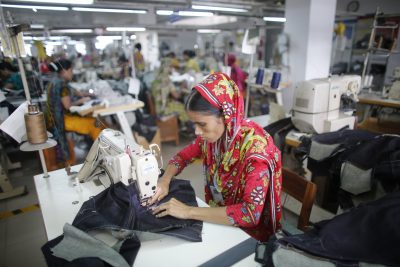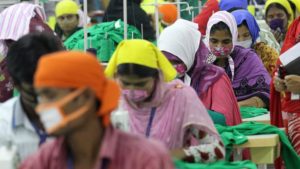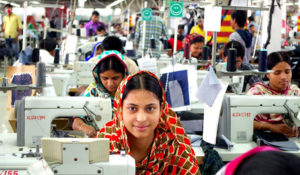Published in The Business Standard on Tuesday 21 January 2020

It is a challenge for us to develop the export structure from a tadpole into a matured one, where variety of export items will be added
Export sector is one of those, where Bangladesh has made a great development in around 50 years after the independence, which is noteworthy at global level.
After Independence, the total amount of exports was several million dollars per year. Gradually it has increased and now it is about 40 billion dollars per year. The target of the 7th five years plan set by the government, which is 60 billion dollars per year, is also very promising. Though it is difficult to achieve, the courage to set the target is a matter of capability.
After the Independence, the main export items were jute and jute-made products, leather, tea, etc. But, from 1980s, readymade garments have been gradually taken the first place and is now leading the export sector.

If the structure of export sector is analysed, we see that it is mainly dependent on readymade garment items. Around 85 percent of total export are garment items. If we see it in a historical perspective, we find that though readymade garments occupy the lion’s share of total exports, other new items have also been added to the list. But the new items do not contribute to the economic growth of the country as the garment items do. As a result, the export sector of Bangladesh has taken the shape of a tadpole, which has a big head and the tail is getting longer. The tail means here the newly added export items, which have a place in the export basket, but not significant. So the tadpole is not growing into a matured one. If we compare it with Vietnam’s scenario, we see that garment items are a significant part of its export basket, but it is not the only item. Other different types of items are also contributing to Vietnam’s economy in a good way. They are not trivial.
So, it is a challenge for us to develop the export structure from a tadpole into a matured one, where variety of export items will be added. If we analyse the export items of Bangladesh from 2001-2018, we see that in 2001, there were no export item which earned one billion dollars. But in 2018, eight items had the capability to earn such amount, though all of them were garment items.
On the other hand, in 2001 in Vietnam, there was one export item that earned one billion dollar or more and which was not garment item. In 2018, 42 items earned the amount each. Seven of those were garment items while the rest were other types of products. So, here we lag behind Vietnam. In 2001, Bangladesh earned 5.4 billion dollars from export while Vietnam earned 15.1 billion dollars, which is around 2.5 times higher than that of Bangladesh. In 2010, Bangladesh earned 15.6 billion dollars while Vietnam earned 72.2 billion dollars. In 2018, Bangladesh earned 40.5 billion dollars while Vietnam earned 243 billion dolalrs, which is five times higher than that of Bangladesh.
Though the dependency on garment items is good for export sector in Bangladesh, the inability to add variety of items is considered a weakness of export strategy. However, readymade garments sector is being diversified now. Inside the garments sector, there are variety of garment related products like linkage goods of woven items. Goods from low price to moderate price are being developed. However, this is not sufficient.
It is assumed from this that the positive effects of the government’s different policies and initiatives to increase export is visible in garment sector. But in diversification of the export items, the limitation of overall policy of the government is getting more severe.
BJMC mills should go private
The government always announces the diversification of export items as a priority in its development and sector wise policy. We find it in the export policies of 2001, 2005, 2010, 2015 and 2018 as well as in the industrial policies and the five years plans. It has also announced to give some supports to increase exports. Alongside, some initiatives are seen in the policies and FDI, BEPZA, BEZA acts to increase export and diversify the products by attracting foreign investments. In SME related policy, export of diversified goods is prioritised.
In these policies, revenue facility, tax facility, financial incentive, low rate interest, exemption facility on imported goods, duty waiver, etc. are announced. Seventeen export related sectors enjoy these facilities now. These types of incentives which were given in 2018-19 fiscal year worth Tk19,800 crore.
The objectives of giving such incentives were to keep the export sector stable, to encourage potential export items and diversify export items.
The lion’s share of the incentives was spent on readymade garments sector. According to a media report it is about 67 percent. It is reasonable due to the size of the RMG industry, its contribution to export, employment and eradicate poverty and its effects on its backward linkage industry.
 At the same time, the government has tried to dig out some emerging sectors with domestic and global helps and through some researches. For example, under the trade support programme of commerce ministry, the government has identified eight sectors as next to RMG. These include leather and leather related goods, light engineering, plastic, agro processing, etc. To encourage the emerging items, the government announces one of the items as the item of an export year. Leather was the item of the year in 2019. It is expected that the incentives and encouragement will play a significant role in boosting export sector.
At the same time, the government has tried to dig out some emerging sectors with domestic and global helps and through some researches. For example, under the trade support programme of commerce ministry, the government has identified eight sectors as next to RMG. These include leather and leather related goods, light engineering, plastic, agro processing, etc. To encourage the emerging items, the government announces one of the items as the item of an export year. Leather was the item of the year in 2019. It is expected that the incentives and encouragement will play a significant role in boosting export sector.
However, the items which got the incentives or declared as the export item of the year, do not yield good harvests. Indeed, opportunities and problems of the sectors, which are declared as emerging, are multidimensional.
In the case of jute-made products, the problems lie inside the industry. The state-owned mills are facing anti-dumping duties as the export prices are less than their production costs. The state-owned jute sector now needs to shift to the private sector due to its weak production system, corruption and mismanagement. Against the backdrop, the government declared 10 percent cash incentive for the jute sector. But, the incentive has nothing to do with the aforementioned problems. We do not see any pragmatic initiative to solve the problems. Gradually the problems are getting more complex. Moreover, the jute export of the private sector is being hindered due to the anti-dumping duties. So the government can reduce Bangladesh Jute Mills Corporation’s (BJMC) activities, make it work on local market, and ensure that it cannot export jute items.
Besides, to encourage private sector’s export, the government can provide subsidised credit to set up small mills. The government can think about setting up small jute mills as well as other factories in private initiatives in the areas of BJMC mills after bringing the areas under EPZs like Adamjee.
Leather sector must not ignore environment
The year 2019 was declared as the export year for leather and leather related goods. The businessmen in the sector have made the government announce that they would be able to earn five billion dollars from leather export by 2023. But in reality, the leather export has rather decreased in 2018-19 fiscal year, which continues in 2019-20. Moreover, during Eid-ul-Azha in 2019, the leather traders had to dump their rawhide in an unexpected situation. Almost every year, the market of rawhide goes through an unrest. The sellers and final buyers of rawhide lack coordination.
Processing of rawhide and the leather market face challenges. Ensuring the environmental standards is the big challenge in this sector. Despite shifting the industry from Hazaribagh to Savar, the environmental standard has not improved. Due to the weakness of Bangladesh Small and Cottage Industries Corporation (BSCIC), failure to take steps in time, dilly-dally of the businessmen and dumping of untreated waste, the leather sector could not gain any benefit from the shift.
Moreover, the image crisis of the industry has prolonged and the Savar Tannery Industrial Estate has failed to meet up the expectations of the foreign buyers. That is why the buyers are now imposing obligations on manufacturers of leather related goods that they must use imported leather in making the products for export. As local leather is not processed properly, they are discouraging the use of it.
Bangladesh imported leather worth 110 million dollars in fiscal year 2018 while it was 72 million dollars in FY2017. That is why making products with artificial leather is getting popular and artificial leather is being imported in the country.
So, the failure to comply with the environmental standards has been damaging the whole leather industry. The initiative to ensure Leather Working Group’s certification and maintain that standard has not proceeded far.
The leather sector got stuck in the conflict between the local market-based leather industry and the global market-based industry. However, the government has allocated an incentive for the export oriented leather industry, which has very little scope of solving the existing challenges in the sector. We cannot utilise the opportunities of the sector due to a lack of pragmatic incentive.
Incentive structure needs reform
The incentive structure should be reformed. It should be more target oriented and restructured to overcome the obstacles in export, especially the issues related to environment. For example, the authority could fine a factory that fails to comply with environmental requirements and give cash incentives to the factory that fulfills the requirements and maintains it.
The government can give priority on diversification of products in the RMG sector. At present, the government is giving incentives to encourage export-related sectors, explore new global market and increase using local raw material. In some cases, the government is giving exemption from VAT to reduce production costs.
The government can also give incentive to fabric producers to encourage producing non cotton fabric. The entrepreneurs who are producing new items, especially value added items, and exporting a sizable amount should be given incentives.
 The government has announced one percent incentive for overall export sector in fiscal year 2019-20. It can be diverted toward the new item producers who export a sizable amount. On the basis of their export earning, two percent incentives can be given to them. It can encourage the entrepreneurs to produce new products. Again, to encourage the use of modern technology and machineries, a portion of market oriented incentive can be provided to the entrepreneurs. The government can consider giving small and medium scale entrepreneurs, who are facing challenges in the market, incentives like helping them make linkage with markets, use modern machineries and produce new items.
The government has announced one percent incentive for overall export sector in fiscal year 2019-20. It can be diverted toward the new item producers who export a sizable amount. On the basis of their export earning, two percent incentives can be given to them. It can encourage the entrepreneurs to produce new products. Again, to encourage the use of modern technology and machineries, a portion of market oriented incentive can be provided to the entrepreneurs. The government can consider giving small and medium scale entrepreneurs, who are facing challenges in the market, incentives like helping them make linkage with markets, use modern machineries and produce new items.
Alongside the government, the private sector stakeholders such as BGMEA and BKMEA should come forward to diversify the RMG sector. For example, the associations can discourage their entrepreneurs to produce the products which have been being produced for 20-25 years in the country. They can arrange pre-evaluation discussions when any new entrepreneur goes for registering to produce a new product. The entrepreneurs will be informed of the products for which they should proceed on for which not at that initial stage. The products which are facing overcapacity problem should be discouraged. It creates problems in negotiation with buyers to get a good price. These initiatives should be in the policy.
Apart from this, the government gives bonded warehouse facility to different sectors like plastic, fabric, paper, ceramic etc. Often we hear about the misuses of this facility. One of the big misuses is to import duty free raw material in the name of using those for export items and then sell the products in local market. As a result, who produce the items only for local market have to compete in an unequal race and the government is denied of revenues. So, ensuring transparency in enjoying bonded warehouse facility is very important. Producing goods for local and global markets at the same time should be prohibited. It will discourage the misuses and the government will be benefitted. Transparency should be ensured in using gas, electricity and realising VAT. There are allegations that the actual utility bills are not paid and it is done with the help of some government officials concerned. The government is deprived of revenues here also.
Though the political intention of the government to diversify the export sector is announced very often, any specific pragmatic initiative is not visible in this regard yet. In fact, the existing incentive structure and the demand of more incentives are concentrating on only a few items instead of diversification. To provide incentives to only a limited number of sectors, the potential and emerging sectors are being deprived due to the resource constraint of the government. So, a massive reform is required in the incentive structure. The incentive structure should be designed to diversify the export items rather to only continue the export. It should be the policy. The incentives should be utilised in the emerging sectors.
Here another thing should be mentioned that while allocating incentives for the RMG in the national budget, the government does not mention the required statistics and information (for example, the amount of money spent as cash incentive for the sector). It is important because then the people concerned will know that how much burden the government has taken to give the incentive. Now, as the entrepreneurs do not know the statistics of how much cash is spent on them, they raise the demand of new incentive next year. So, not only the rate but also the amount spent on the sectors should be announced publicly.
Secondly, the purpose of giving the incentives also needs to be made public. The evaluation of the sector before and after giving the incentives should be done from time to time. The government is being deprived as it does not have the information on whether the sector has been benefitted due to the incentives or not. The government remains in dark about the necessity or the benefit of giving the incentives.
Again, the period of availing the advantage is also not mentioned. So, the businessmen who enjoy the facility forget about it and no stress works in their minds. A time limit should be there for enjoying the incentive facility.
In 1980s, the government gave some facilities in exchange rate and introduced dual exchange rate to boost export. Some sectors are demanding the facility again. Actually, considering the importance of export and import in Bangladesh at present, there is no scope of dual exchange rate. Rather the government can keep the exchange in balance by buying and selling foreign currencies through the managed floating exchange rate that is currently maintained by the government in perspective of global market. If the exchange rate is maintained considering only export sector, it will affect other sectors negatively. Exchange rate devaluation is another kind of incentive the businessmen are demanding. But it will not give any significant benefit to export. So, the commerce ministry or finance ministry should consider the rational things through discussion with the businessmen.
We see the government has a tendency to give short-term incentives rather than long-term and these are national budget centred. Some stakeholders invest a large amount keeping the budget in mind and raise their demands to the government in different ways. These short-term incentives hinder the long-term perspective of export diversification and development of industrial sector. The small and medium entrepreneurs and businessmen suffer the most due to it as they do not have any influential connection in political arena. Though they raise their issues to the government, their issues get lost under other big issues. But these are important as potential sectors or items in diversification of export items. So, this is another political-financial dimension of incentives which is affecting our export sector adversely.
The author is Research Director at the Centre for Policy Dialogue.



